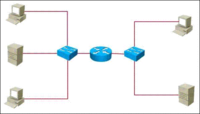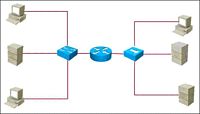PlAwAnSaI
Administrator
640-875 SPNGN1 Exam Topics
Exam Description
The 640-875 Building Cisco Service Provider Next-Generation Networks, Part 1 exam is associated with the CCNA SP certification. This exam tests a candidate basic knowledge and skills necessary to support a service provider network. Candidates can prepare for this exam by taking the Building Cisco Service Provider Next-Generation Networks, Part 1 (SPNGN1) course.
Exam Topics
The following topics are general guidelines for the content likely to be included on the Building Cisco Service Provider Next-Generation Networks, Part 1 exam. However, other related topics may also appear on any specific delivery of the exam. In order to better reflect the contents of the exam and for clarity purposes, the guidelines below may change at any time without notice.
IP Networks
[li]Describe the purpose and functions of various network devices (at the core, distribution, and access layers)[/li]
[li]Identify the functional components required to meet a given network specification[/li]
[li]Describe the OSI and TCP/IP models and their associated protocols to explain how data flows in a network[/li]
[li]Describe common network applications and their impact on the network[/li]
[li]Interpret network diagrams[/li]
[li]Troubleshoot common network problems at layers 1, 2, 3, 4, and 7 using a layered model approach[/li]
[li]Describe differences between LAN and WAN operation and features[/li][/list]
IPv4 and IPv6 Addressing
[li]Describe the structure of IPv4 and IPv6 addresses[/li]
[li]Describe VLSM, CIDR and route summarization concepts[/li]
[li]Describe the different types of IPv4 and IPv6 addresses[/li]
[li]Design an IP subnetting plan based on given requirements[/li][/list]
Switched Network Technologies I
[li]Describe bridging concepts and Layer 2 Ethernet frames[/li]
[li]Configure basic Spanning Tree operations on Cisco IOS Switches[/li]
[li]Interpret the output of various basic show and debug commands to verify the operational status of a Cisco switched network[/li]
[li]Configure basic switch security (i.e, port security, securing unused ports)[/li]
[li]Describe Ethernet link bundling, LACP, and PAgP and Flex Links[/li][/list]
Routed Network Technologies I
[li]Describe classful versus classless routing[/li]
[li]Describe routing protocols basics (metrics, IGP versus EGP)[/li]
[li]Describe RIPv1, RIPv2, RIPNG[/li]
[li]Implement EIGRPv4 and EIGRPv6 on Cisco IOS, IOS-XE and IOS-XR routers[/li]
[li]Describe route redistribution[/li]
[li]Describe VRF[/li]
[li]Describe GRE[/li][/list]
IP Services
[li]Configure NAT (IPv4) on Cisco routers[/li]
[li]Configure DHCP (IPv4 and IPv6) operations on Cisco routers[/li]
[li]Describe ICMPv4 and ICMPv6[/li]
[li]Describe DNS[/li][/list]
Cisco Operating Systems and Platforms I
[li]Implement basic Cisco IOS, IOS-XE and IOS-XR CLI operations[/li]
[li]Implement basic Cisco IOS, IOS-XE and IOS-XR routers configurations[/li][/list]
Transport Technologies
[li]Describe SONET and SDH[/li]
[li]Describe DWDM, IPoDWDM, and ROADM[/li]
[li]Configure 10 Gigabit Ethernet, 40 Gigabit Ethernet, and 100 Gigabit Ethernet interfaces on Cisco routers[/li]
[li]Describe Frame Relay[/li]
[li]Describe ATM[/li]
[li]Describe Metro Ethernet[/li]
[li]Describe DSL[/li]
[li]Describe T1, T3, E1, E3, and ISDN[/li]
[li]Implement PPP encapsulation on Cisco routers serial and POS interfaces[/li]
[li]Describe cable (DOCSIS)[/li]
[li]Describe the main BRAS and BNG routers functions in IP NGN[/li]
[li]Describe various Passive Optical Network (PON) access technologies and FTTx[/li][/list]
Security in the Network
[li]Describe Layer 2 security features on Cisco IOS switches[/li]
[li]Configure management plane security on Cisco routers and IOS switches[/li]
[li]Describe IPsec[/li]
[li]Describe control plane security[/li]
[li]Configure basic AAA (TACACS+ and RADIUS) services on Cisco routers[/li]
[li]Configure routing protocols authentication between Cisco routers[/li]
[li]Describe the relationships between users, user groups, tasks groups and task IDs in IOS-XR[/li]
[li]Describe common types of network attacks[/li][/list]
Network Management
[li]Configure NTP server or client on Cisco routers[/li]
[li]Configure IP SLA on Cisco routers[/li]
[li]Configure CDP on Cisco routers and IOS switches[/li]
[li]Configure SNMP on Cisco routers[/li]
[li]Configure NetFlow on Cisco routers[/li]
[li]Configure logging to Syslog server on Cisco routers[/li]
[li]Describe the Cisco IOS Call-Home feature[/li]
[li]Describe Cisco TAC procedure and navigate Cisco support tools (CCO)[/li]
[li]Implement management access (SSH, telnet, and out-of-band management design)[/li]
[li]Implement SPAN, RSPAN, and ERSPAN[/li]
[li]Implement file transfers to manage network devices configurations and images using FTP, SCP, TFTP, SFTP, and RCP[/li][/list]
Set authentication, frame-relay, NAT, DHCP
ข้อแตกต่างของ RIP, OSPF และ EIGRP
PAP & CHAP
เครือข่ายความเร็วสูง, SONET/SDH
VRF คืออะไร เอาไว้ทำอะไร ?
IOS XR
Variable Length Subnet Mask (VLSM)
Internet Protocol version 6 (IPv6)
DWDM เทคโนโลยีสื่อสารความเร็วสูงสำหรับเส้นใยแก้ว
SNMP & SNMP Trap
Cisco IOS IP Service Level Agreement (SLA)
ME3400
เกี่ยวกับ IEEE 802
NetFlow
[li]Routing protocol authentication
[/list]
[li]MD5 passwords are never sent to a peer.[/li]
[li]Routers authenticate each routing update packet received.[/li]
[li]MD5 authentication must be configured with the same password on both BGP peers.[/li][/list]
[/li]
[li]Private IP Address (RFC 1918) คือ IP Address ที่สงวนไว้สำหรับใช้ภายในองค์กร โดยที่หมายเลข IP
Address เหล่านี้ไม่สามารถนำไปใช้งานใน Internet ได้
[li]Class A = 10.0.0.0 - 10.255.255.255[/li]
[li]Class B = 172.16.0.0 - 172.31.255.255[/li]
[li]Class C = 192.168.0.0 - 192.168.255.255[/li][/list]
[/li]
ARP, RARP, Proxy ARP, Gratuitous ARP and IP Redirect คือ ?
Code:
http://www.ciscoclub.in.th/index.php?topic=715
Code:
http://en.wikipedia.org/wiki/EtherType
เร้าติ้งโปรโตคอลแบ่งตาม Classless และ Classful
Code:
http://www.gotoknow.org/blogs/posts/306789
ทำความรู้จักกับ Port Security บน Cisco Catalyst Switch
Code:
http://running-config.blogspot.com/2011/01/port-security-cisco-catalyst-switch.html
Code:
http://www.cisco.com/en/US/docs/switches/lan/catalyst6500/ios/12.2SX/configuration/guide/port_sec.html
Reliable Delivery and Filtering for Syslog
Code:
http://www.cisco.com/en/US/docs/ios/12_4t/12_4t11/htnmsylg.html
Command Copy TFTP Running-config This command lets you merge your backed up config
Code:
http://www.howtonetwork.net/public/659.cfm

Exam Description
The 640-875 Building Cisco Service Provider Next-Generation Networks, Part 1 exam is associated with the CCNA SP certification. This exam tests a candidate basic knowledge and skills necessary to support a service provider network. Candidates can prepare for this exam by taking the Building Cisco Service Provider Next-Generation Networks, Part 1 (SPNGN1) course.
Exam Topics
The following topics are general guidelines for the content likely to be included on the Building Cisco Service Provider Next-Generation Networks, Part 1 exam. However, other related topics may also appear on any specific delivery of the exam. In order to better reflect the contents of the exam and for clarity purposes, the guidelines below may change at any time without notice.
IP Networks
[li]Describe the purpose and functions of various network devices (at the core, distribution, and access layers)[/li]
[li]Identify the functional components required to meet a given network specification[/li]
[li]Describe the OSI and TCP/IP models and their associated protocols to explain how data flows in a network[/li]
[li]Describe common network applications and their impact on the network[/li]
[li]Interpret network diagrams[/li]
[li]Troubleshoot common network problems at layers 1, 2, 3, 4, and 7 using a layered model approach[/li]
[li]Describe differences between LAN and WAN operation and features[/li][/list]
IPv4 and IPv6 Addressing
[li]Describe the structure of IPv4 and IPv6 addresses[/li]
[li]Describe VLSM, CIDR and route summarization concepts[/li]
[li]Describe the different types of IPv4 and IPv6 addresses[/li]
[li]Design an IP subnetting plan based on given requirements[/li][/list]
Switched Network Technologies I
[li]Describe bridging concepts and Layer 2 Ethernet frames[/li]
[li]Configure basic Spanning Tree operations on Cisco IOS Switches[/li]
[li]Interpret the output of various basic show and debug commands to verify the operational status of a Cisco switched network[/li]
[li]Configure basic switch security (i.e, port security, securing unused ports)[/li]
[li]Describe Ethernet link bundling, LACP, and PAgP and Flex Links[/li][/list]
Routed Network Technologies I
[li]Describe classful versus classless routing[/li]
[li]Describe routing protocols basics (metrics, IGP versus EGP)[/li]
[li]Describe RIPv1, RIPv2, RIPNG[/li]
[li]Implement EIGRPv4 and EIGRPv6 on Cisco IOS, IOS-XE and IOS-XR routers[/li]
[li]Describe route redistribution[/li]
[li]Describe VRF[/li]
[li]Describe GRE[/li][/list]
IP Services
[li]Configure NAT (IPv4) on Cisco routers[/li]
[li]Configure DHCP (IPv4 and IPv6) operations on Cisco routers[/li]
[li]Describe ICMPv4 and ICMPv6[/li]
[li]Describe DNS[/li][/list]
Cisco Operating Systems and Platforms I
[li]Implement basic Cisco IOS, IOS-XE and IOS-XR CLI operations[/li]
[li]Implement basic Cisco IOS, IOS-XE and IOS-XR routers configurations[/li][/list]
Transport Technologies
[li]Describe SONET and SDH[/li]
[li]Describe DWDM, IPoDWDM, and ROADM[/li]
[li]Configure 10 Gigabit Ethernet, 40 Gigabit Ethernet, and 100 Gigabit Ethernet interfaces on Cisco routers[/li]
[li]Describe Frame Relay[/li]
[li]Describe ATM[/li]
[li]Describe Metro Ethernet[/li]
[li]Describe DSL[/li]
[li]Describe T1, T3, E1, E3, and ISDN[/li]
[li]Implement PPP encapsulation on Cisco routers serial and POS interfaces[/li]
[li]Describe cable (DOCSIS)[/li]
[li]Describe the main BRAS and BNG routers functions in IP NGN[/li]
[li]Describe various Passive Optical Network (PON) access technologies and FTTx[/li][/list]
Security in the Network
[li]Describe Layer 2 security features on Cisco IOS switches[/li]
[li]Configure management plane security on Cisco routers and IOS switches[/li]
[li]Describe IPsec[/li]
[li]Describe control plane security[/li]
[li]Configure basic AAA (TACACS+ and RADIUS) services on Cisco routers[/li]
[li]Configure routing protocols authentication between Cisco routers[/li]
[li]Describe the relationships between users, user groups, tasks groups and task IDs in IOS-XR[/li]
[li]Describe common types of network attacks[/li][/list]
Network Management
[li]Configure NTP server or client on Cisco routers[/li]
[li]Configure IP SLA on Cisco routers[/li]
[li]Configure CDP on Cisco routers and IOS switches[/li]
[li]Configure SNMP on Cisco routers[/li]
[li]Configure NetFlow on Cisco routers[/li]
[li]Configure logging to Syslog server on Cisco routers[/li]
[li]Describe the Cisco IOS Call-Home feature[/li]
[li]Describe Cisco TAC procedure and navigate Cisco support tools (CCO)[/li]
[li]Implement management access (SSH, telnet, and out-of-band management design)[/li]
[li]Implement SPAN, RSPAN, and ERSPAN[/li]
[li]Implement file transfers to manage network devices configurations and images using FTP, SCP, TFTP, SFTP, and RCP[/li][/list]
Set authentication, frame-relay, NAT, DHCP
ข้อแตกต่างของ RIP, OSPF และ EIGRP
PAP & CHAP
เครือข่ายความเร็วสูง, SONET/SDH
VRF คืออะไร เอาไว้ทำอะไร ?
IOS XR
Variable Length Subnet Mask (VLSM)
Internet Protocol version 6 (IPv6)
DWDM เทคโนโลยีสื่อสารความเร็วสูงสำหรับเส้นใยแก้ว
SNMP & SNMP Trap
Cisco IOS IP Service Level Agreement (SLA)
ME3400
เกี่ยวกับ IEEE 802
NetFlow
[li]Routing protocol authentication
[/list]
[li]MD5 passwords are never sent to a peer.[/li]
[li]Routers authenticate each routing update packet received.[/li]
[li]MD5 authentication must be configured with the same password on both BGP peers.[/li][/list]
[/li]
[li]Private IP Address (RFC 1918) คือ IP Address ที่สงวนไว้สำหรับใช้ภายในองค์กร โดยที่หมายเลข IP
Address เหล่านี้ไม่สามารถนำไปใช้งานใน Internet ได้
[li]Class A = 10.0.0.0 - 10.255.255.255[/li]
[li]Class B = 172.16.0.0 - 172.31.255.255[/li]
[li]Class C = 192.168.0.0 - 192.168.255.255[/li][/list]
[/li]
ARP, RARP, Proxy ARP, Gratuitous ARP and IP Redirect คือ ?
Code:
http://www.ciscoclub.in.th/index.php?topic=715
Code:
http://en.wikipedia.org/wiki/EtherType
เร้าติ้งโปรโตคอลแบ่งตาม Classless และ Classful
Code:
http://www.gotoknow.org/blogs/posts/306789
ทำความรู้จักกับ Port Security บน Cisco Catalyst Switch
Code:
http://running-config.blogspot.com/2011/01/port-security-cisco-catalyst-switch.html
Code:
http://www.cisco.com/en/US/docs/switches/lan/catalyst6500/ios/12.2SX/configuration/guide/port_sec.html
Reliable Delivery and Filtering for Syslog
Code:
http://www.cisco.com/en/US/docs/ios/12_4t/12_4t11/htnmsylg.html
Command Copy TFTP Running-config This command lets you merge your backed up config
Code:
http://www.howtonetwork.net/public/659.cfm










